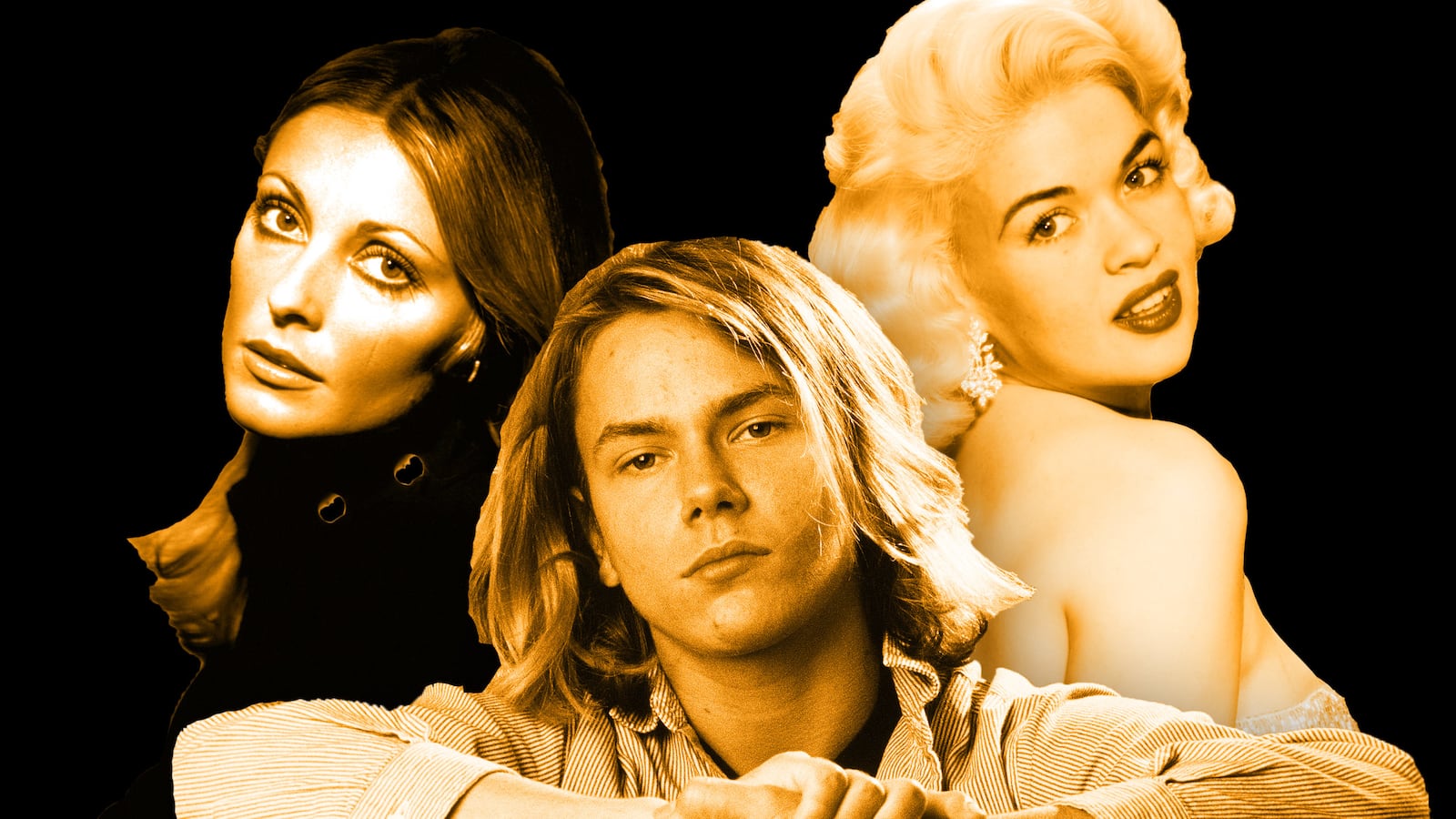“Every man’s life ends the same way,” Ernest Hemingway once famously philosophized. “They say you die twice—once when you stop breathing and a second time when somebody says your name for the last time,” offered Banksy several decades later. It all rings truest in the celebrity mecca that is Hollywood, where Tinseltown’s most famous have met ends both ordinary and extraordinary and forgotten souls haunt streets caked in stardust dreams, and where death itself is the most titillating tourist attraction of them all.
“Every city has a murder tour,” smiled Scott Michaels, the proprietor of celebrity death specialists Dearly Departed Tours, on a sunny October afternoon at his Sunset Blvd. storefront. “Ours just happens to be of famous people.”
Michaels, 54, has been guiding curiosity-seekers through Hollywood’s hidden landscape of celebrity death and scandal for a decade and a half. He’s a self-styled expert on the Manson family murders, the subject of one of his most in-depth and popular tours and, arguably, the most notorious and fascinating violent crime in Los Angeles history.
His Tragical History Tour takes visitors across the city, stopping everywhere from the Holmby Hills home Michael Jackson died in to the Menendez family mansion, past the Beverly Hilton Hotel where Whitney Houston died from drowning and the West Hollywood pay phone used to dial 911 when River Phoenix overdosed 23 years ago this week outside the Viper Room.
“People are so used to history being in books,” Michaels explained. “They don’t realize that this city is a giant book.”
If our tabloid obsession with the lives of famous people is a subconscious form of idol worship, then indulging in the circumstances of their misfortune is the other side of the coin—that which most definitively closes the distance between us and those who exist on pedestals in the clouds, high above mere mortals. Tragedy humanizes even the most deified of celebrities. Sensational deaths in this city, whether it’s the Black Dahlia or Biggie Smalls, have a way of making unknown faces known and unsolved murders into legends. In death, equality.
Michaels’ fixation with death stories began as a child growing up in Detroit. “I went to a funeral when I was really young, like 3 years old, and I remember not really processing it,” he said. Years later when a girl he knew was killed inside a Kentucky Fried Chicken restaurant, he and the kids in town would go hang out there, compelled by the association. “That was 40-something years ago, and nobody remembers her—but I remember her very well.”
Death tourism, he says very genuinely, “is a way of remembering people. And everyone can relate to somebody famous.”
For Michaels, it’s not all about murder. One of his most personal treasures is the entire door to the room at the Regency Plaza Suites Hotel that Hairspray star Divine died in, which rests propped up against a wall greeting all who enter the modest bi-level headquarters and gallery of Dearly Departed Tours. He paid a security guard to look the other way and took it right off the hinges, but not before laying down on the spot where the John Waters muse passed away, at the age of 42, of an enlarged heart.
A movie buff who has a tattoo of Freaks star Schlitzie on his arm and an entire case of The Rocky Horror Picture Show memorabilia in his store, Michaels started collecting artifacts of death when he was 15, after another horrific hometown crime, the rape and murder of a girl, left him so moved he and a friend drove to the house where it happened and pried the address sign off with a screwdriver.
“That house is long, long gone,” he said. “The address is upstairs. I don’t know whatever to do with it. It was just a kind of bizarre tribute. A very selfish one, technically.” He moved on to commemorating famous deaths, keeping the habit of collecting tangible bits and pieces of the buildings, objects, and places where exceptional lives were lost. “These multimillion-dollar corporations are tearing down these places and here’s me scrambling over a fence, just to grab a brick.”
If the bits of wall and wood and concrete in his gallery could talk, they’d tell profoundly pedestrian and legendary stories. The latest addition, a partial tree branch mounted on the foyer wall, was a gift: A piece of a tree that no longer exists, which was destroyed after the car Paul Walker was riding in hit it, then burst into flames. The object that tends to attract the most attention in his shop is a chunk of Sharon Tate’s fireplace, which sits next to a tiny square of glass preserved from the car wreck that killed Jayne Mansfield.

“I joke with people, ‘If you hold it up to your ear, ha ha ha…,’ but there is an element of that that’s real as far as what is attached to that,” said Michaels, who also owns pieces of Brian Jones’ swimming pool and John Denver’s airplane and recently purchased the entire Mansfield car, which he plans on putting on display next year.
He says the shop and gallery are protected by holy water, sage, minerals, stones, and Hawaiian salt for extra measure—and may or may not be haunted. “All these things are in here. It stands to reason that there might be something attached to them. I just figured it wouldn’t hurt to be safe.”
Does the act of transporting ourselves into the real-life tragedies of others, even for a brief moment, give us some greater appreciation for our own lives? I asked Michaels. Is death, essentially, simply what gives life meaning?
“I don’t think so,” he smiled. “I think people just like it because it’s trashy and gossipy.”
He considered the why of it all more deeply. “Sometimes people who confront things like murder or disease in their own lives, they’re a bit more open to this. I have had a lot of people that are terminally ill take this tour. They think it’s a hoot. It’s not the reason they’re taking this tour, but it’s part of the reason they feel comfortable taking it.”
When he takes clients on his multimedia Helter Skelter bus tour, an exhaustive three-hour reconstruction of the known movements of the victims and perpetrators leading up to the Tate-LaBianca murders, part of the experience is tracing the steps of the killers. A personal favorite LA spot is the Canyon Country Store frequented by Jim Morrison and the 1960s rock scene. In a way, visiting these places is also a form of time travel.
“There are a lot of times when I visit these locations and I will put myself into them. The room where Divine died, I laid down right where she died.” He did the same in Mae West’s apartment. “I was laying there thinking, ‘This is the last thing she ever saw.’” He tends not to talk about any of the ghosts he’s encountered because he knows it sounds silly to skeptics. The only time he’s truly felt creeped out was when he visited the Wonderland murder house and laid down where one of the victims had been killed.
When he bought the Jayne Mansfield car, he spent a moment sitting in the same seat she died in and felt an unexplainable flash. “I don’t know what it was, but it happened and it was really pretty powerful,” he said, quietly. “It’s as close as I can get to actually being there. To me, that’s trying to experience history.”

Morbid tourism is such a growing industry that in Los Angeles alone you have your pick from ghost tours, ghost-hunting tours, haunted Hollywood tours, TMZ tours, even the old standby Star Maps you can pick up in newspaper machines on street corners. Michaels has been thinking of adding an O.J. Simpson tour to his repertoire, since so many people have come in asking for one after watching FX’s award-winning The People v. O.J. Simpson series.
But he admits he’s a bit turned off by the Simpson case, much like the fascination he once had with serial killers like John Wayne Gacy and Jeffrey Dahmer, whose original artwork hangs on his walls, has faded over the years. Instead, he’s mulling a true crime tour of sites throughout Los Angeles that have borne witness to spectacular deaths, like the guy who killed his roommate with a rented chainsaw and got caught when he returned it the next day without cleaning off the motor.
“I’ve morphed. I don’t want to focus on the serial killer stuff anymore,” Michaels said. “Serial killer people and celebrity death people are different. It’s like Manson people—there are [Sharon Tate] victim people, and there are [Charles] Manson people. I run across both of them a lot.”
He also readily admits that the business he’s in is exploitative at its core, even if there are a million reasons tourists from all over the world seek out his tours. “I’ve come to grips with the fact that I’m comfortable in my own skin, and I gave up trying to win everybody over a long time ago,” he shrugged. “What’s the difference between visiting Auschwitz and where the Wonderland murders happened? I know socially it’s more profound. But I find it all very interesting. You draw the line, not me.”
To offset the balance of the universe Dearly Departed donates partial proceeds to charities associated with the celebrities they highlight, and has quietly purchased gravestones for various obscure actors and actresses, forgotten by Hollywood, who have been laid to rest in unmarked graves across the city. Michaels, by the way, has two of his own future resting places already reserved for the day he shuffles off this mortal coil.
“I’m afraid of how I’m going to die, but I just know there’s something bizarre in store for me,” he smiled. “That’s just karma.”






